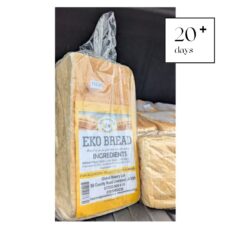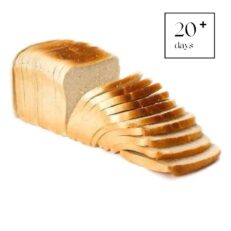Think about your favourite loaf, soft, sliced, maybe with a crust that gives a gentle crunch, warm butter melting in. Now imagine something fluffier, slightly sweet, stretchy, warm from the bakery, that pulls apart almost like a cloud. That’s Agege Bread, a Nigerian classic that rivals many British loaves in comfort, texture, and sheer character.
In this post, you’ll get the inside story on what makes Agege so beloved, how it stacks up against British loaves (think sliced white, sourdough, farmhouse), health trade-offs, ways to use it, and why more people in the UK are turning to Agege for their daily bread fix.
Table of Contents
What It Is / Origin Story
Agege Bread is a sweet, yeasted white wheat bread that originated in Agege, Lagos State, Nigeria. It’s baked in rectangular lidded pans similar to a Pullman loaf, but its defining traits are its soft, fluffy interior and slightly sweet flavour.
Its history stretches back to the early 20th century, notably through Amos Stanley Wynter Shackleford, a Jamaican who migrated to Lagos. He brought bread-making techniques and opened one of the first popular bakeries in Ebute Metta, and even after his bakery’s decline in the 1960s, local bakers (like Alhaji Ayokunnu) revived the techniques, preserving the taste and texture that people had come to love. “Agege Bread” is named both after the place and the legacy.
British Loaves vs Agege Bread: The Clash of Crust and Comfort
To understand why Agege is often preferred by many, it helps to compare it with common British loaves. Here are some typical British styles:
- White sliced loaf: Soft crust, uniform crumb, widely available, used for toast, sandwiches.
- Farmhouse or bloomer: Rustic crust, open crumb, often baked in tins or free-form, more texture.
- Sourdough / artisan loaves: Harsh crust, tangy flavour, dense crumb, longer fermentation.
What Agege brings into this mix:
| Feature | Agege Bread | Typical British White Loaf / Sliced |
|---|---|---|
| Crumb softness & elasticity | Very soft, stretchy, sometimes slightly sticky inside; pulls apart easily. | Soft but more structured; less stretch; slices maintain shape well. |
| Sweetness | Slightly sweet taste because of added sugar and sometimes milk or margarine. | Usually less sweet; sweetness mainly from crust browning or small sugar additions. |
| Crust & chew | Thin crust, soft outer skin; chewy just under crust. | Thicker crusts in artisan or farmhouse loaves; sliced white loaves often have thin crust but firmer outer texture. |
| Cost & availability (in communities) | Very affordable in Nigerian and West African communities; made in large volumes; popular street loaf. | Widely available in UK supermarkets; prices vary a lot depending on artisan vs mass-produced loaves. |
| Cultural / emotional value | Huge nostalgia; often eaten with beans, akara, or use for tea, or just butter; part of everyday life in Nigeria. | Bread is central to UK routines too; toast, sandwiches, etc., but less tied to heritage or emotional identity for many. |
Health Benefits & Nutritional Insights
No bread is perfectly “healthy” in all ways, it’s about what you use it with and how often. Here’s what Agege bread offers, and what to watch out for:
What it gives you:
- Energy from carbohydrates is good for those needing fuel (especially in active families or long days).
- Protein, though modest, from wheat flour; some variants include milk or margarine, which can add small amounts of additional fat or nutrients.
- Enjoyment and satiety: its softness and flavour make it likely to be eaten, enjoyed, and filling.
What to consider:
- Sugar content: Agege often has added sugar to get its slight sweetness and to help browning. Overuse can contribute to excess sugar intake.
- Refined flour: It’s usually made from white wheat flour, which is lower in fibre and some micronutrients compared to wholemeal or artisan breads.
- Storage & preservatives: Mass-produced Agege bread may include dough improvers or preservatives to keep softness over several days. The fresher it is, the better.
Recommended products
Our Signature Eko Soft Agege Bread Range
| Product Name | Description | Pack Size / Offer |
|---|---|---|
| Eko Soft Agege Bread 800g | Authentic Nigerian white bread loaf, soft, fluffy, and full of flavour. | Single loaf |
| Eko Soft Agege Sliced Bread 800g | Traditional Nigerian sliced bread, same great taste, ready to serve. | Single loaf |
| Eko Soft Agege Bread 800g x5 Case | Great for families and events, save more when you buy in bulk. | Case of 5 loaves |
| Eko Soft Agege Sliced Bread 800g x5 Case | Perfect for shared households or catering services convenient and fresh. | Case of 5 loaves |
| Eko Soft Agege Bread 800g x10 Case | Ideal for bulk buyers and small businesses with freshness guaranteed. | Case of 10 loaves |
| Eko Soft Agege Sliced Bread 800g x10 Case | Same soft taste, more convenience, slice by slice perfection. | Case of 10 loaves |
Recipes / How to Use Agege Bread
Here are ways to use Agege bread that show off its strengths, how it beats many standard loaves in texture and flavour for certain uses:
- Toast-and-Tea Morning Combo: Warm a slice, butter it, pair with hot tea or cocoa, the softness melts with butter in a way many sturdier slices don’t.
- Bean Stew & Agege: Use Agege to mop up stews (e.g., Nigerian Ewa Agoyin) its stretchy crumb sucks up sauce well.
- Sandwich Extreme: Make sweet/savoury combos such as ham and cheese, peanut butter and banana, or even jam; the bread’s sweetness makes it work without being bland.
- Bread Pudding Style Dessert: Use stale Agege for a pudding with milk, sugar, egg its soft crumb absorbs custard beautifully.
Recommended products
Where Agege Bread Fits Best
Agege shines in situations many British loaves don’t:
- When you want scoopers for stew rather than firm slices.
- If you want something soft that kids will eat with dread for crumbs avoided.
- For breakfast or street-style consumption, where speed and comfort matter more than crust or artisan shape.
FAQ (People Also Ask)
Q: What exactly is Agege bread made from?
A: Typically wheat flour, sugar, yeast, water, a bit of margarine or fat, sometimes milk. The sugar and fat contribute to its soft texture and slight sweetness.
Q: How long does Agege bread stay soft?
A: Usually 2-4 days when fresh, kept in a cool, dry place. The soft crust tends to harden after that unless reheated.
Q: Is Agege bread better for you than some British loaves?
A: Depends. For certain uses (comfort, texture, sauce pairing), Agege may outperform typical white sliced loaf. But for nutrition (fibre, whole grains), wholemeal or sourdough may win.
Q: Can I use Agege bread for toast?
A: Absolutely. It toasts well; it gets golden on the outside while staying soft inside, great with butter, jam, or even savoury toppings.
Q: Where can I buy authentic Agege bread in the UK?
A: African or world-food grocery stores online often stock it; some bakeries specialise in it.
Bringing the Bread Battle Down to Taste
British loaves have their place for toast, sandwiches, artisanal crusts, sourdough flavour. But Agege brings something unique: softness, sweetness, stretch, and comfort. For many, it’s not just better it’s exactly what they want in everyday eat.
So the next time you reach for bread, consider this: your favourite British loaf may win in crispiness or flavour complexity. But for pure comfort, soft chew, and that nostalgic warmth… Agege Bread might just take the crown.
Related Reads
- The Untold Story of Maggi Cubes: The Tiny Seasoning Behind Big Holiday Flavours
- 10 Must-Have Foods and Drinks to Light Up Your Diwali Feast
- 4Way Foods Featured in Yahoo Finance and The Grocer: A New Chapter for Online Grocery Shopping
- Discover Nurishment Strawberry, Vanilla, Chocolate and Banana Drinks
- The Top 30 Must-Have Seasonings Every Christmas Kitchen Needs
- How Dalgety Herbal Teas Became the UK’s Best-Kept Winter Wellness Secret
- The Best Rice Varieties for Christmas: From Jollof to Fried Rice
- The Secret Ingredient Chefs Won’t Admit They Use: Premium Salt Varieties
- Why Schweppes Is Still the UK’s Number One Mixer This Festive Season
- Why Generations of Parents Still Trust Cerelac — The Story Behind the Brand
- Spice Up Your Christmas: The Ultimate Guide to Seasonings You Can’t Live Without
- Is Nurishment the UK’s Best Kept Nutrition Secret? We Investigate
- 10 Creative Indomie Recipes That Go Way Beyond Instant Noodles
- Caribbean Choice UK: Celebrating Caribbean Flavours with 4Way Foods
- From Jamaica With Love: The Colourful History of Bigga Drinks
- Kenyan Online Supermarket: Groceries Delivered to Your Door
- Top 20 Caribbean Foods and Drinks at Carnival (External Blog)
- How to Host a Carnival-Themed Party at Home
- Why Grace Foods Is the Heinz of the Caribbean Kitchen
- The Untold Story of the Brands Behind World Foods
- Top 12 African Supermarkets and Grocers in the UK
- Onga: The Seasoning Brand at the Heart of African Cooking


